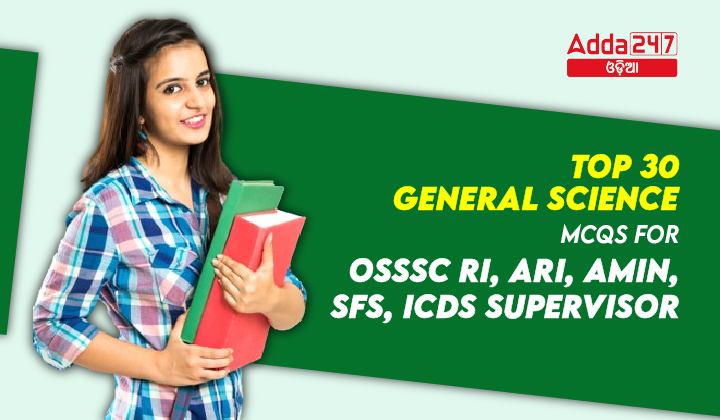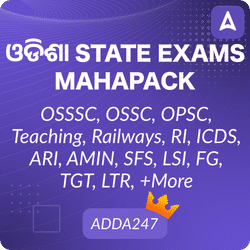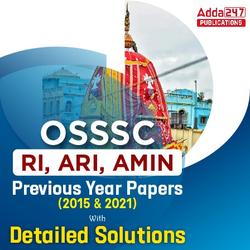General Science forms an essential part of many competitive exams in India, including those conducted by the Odisha Sub-ordinate Staff Selection Commission (OSSSC) for various positions like Revenue Inspector (RI), Assistant Revenue Inspector (ARI), Amin, SFS, and ICDS Supervisor. To excel in these exams, candidates must have a strong grasp of fundamental scientific concepts. Here, we present the top 30 General Science multiple-choice questions (MCQs) to help candidates prepare effectively.
Top 30 General Science MCQS For OSSSC RI,ARI, Amin, SFS, ICDS Supervisor
- What is the full form of IN-SPACe?
A) Indian Space Research Organization
B) Indian National Space Promotion and Authorisation Centre
C) International Space Station
D) Indian Space Exploration CentreAnswer: B) Indian National Space Promotion and Authorisation CentreExplanation: IN-SPACe stands for Indian National Space Promotion and Authorisation Centre, as mentioned in the provided information.
- Which country inaugurated the Satellite & Payload Technical Centre in Ahmedabad?
A) China
B) Russia
C) India
D) United StatesAnswer: C) IndiaExplanation: The Satellite & Payload Technical Centre in Ahmedabad was inaugurated by Union Minister of State for Science and Technology, Jitendra Singh, representing India’s advancements in the space sector.
- What is the primary focus of the Technical Centre inaugurated by IN-SPACe?
A) Rocket propulsion systems
B) Satellite and payload testing
C) Astronaut training
D) Deep space explorationAnswer: B) Satellite and payload testingExplanation: The Technical Centre established by IN-SPACe in Ahmedabad primarily focuses on satellites and payloads, along with provisions for launch vehicle simulation and mission planning.
- What was the approximate investment made by private entities in India’s space sector between April and December 2023?
A) ₹500 crore
B) ₹1000 crore
C) ₹2000 crore
D) ₹3000 croreAnswer: B) ₹1000 croreExplanation: Private entities invested ₹1000 crore in India’s space sector between April and December 2023, reflecting increased participation and interest in the space industry.
- What are the key features of the Satellite & Payload Technical Centre inaugurated by IN-SPACe?
A) Equipped with a Climate Simulation Test Facility and a Thermal and Vacuum Environment Simulation Facility
B) Focus on rocket manufacturing and launch operations
C) Located in Mumbai, the financial capital of India
D) Specializes in underwater exploration technologyAnswer: A) Equipped with a Climate Simulation Test Facility and a Thermal and Vacuum Environment Simulation FacilityExplanation: The Satellite & Payload Technical Centre inaugurated by IN-SPACe in Ahmedabad is equipped with cutting-edge resources including a Climate Simulation Test Facility, Thermal and Vacuum Environment Simulation Facility, and Space Systems Design Lab, as mentioned in the provided information.
- How many new moons were discovered in the outer reaches of our solar system according to the article?
A) One around Uranus and two around Neptune
B) Two around Uranus and one around Neptune
C) Three around Uranus
D) Three around NeptuneAnswer: B) Two around Uranus and one around NeptuneExplanation: The article states that astronomers identified three new moons, with two orbiting Neptune and one around Uranus.
- What technique was primarily used for the discovery of these new moons?
A) Radar imaging
B) Space probes
C) Long-exposure photography with powerful telescopes
D) Satellite observationsAnswer: C) Long-exposure photography with powerful telescopesExplanation: The article mentions that astronomers utilized long-exposure photography over several nights with some of the largest telescopes worldwide to detect the new moons.
- Who led the efforts in discovering the new moons using the Magellan Telescope in Chile and the Subaru Telescope in Hawaii?
A) David Tholen
B) Chad Trujillo
C) Patryk Sofia Lykawa
D) Scott SheppardAnswer: D) Scott SheppardExplanation: Scott Sheppard led the efforts in discovering the new moons using the mentioned telescopes.
- What is the provisional name given to Uranus’ latest moon, discovered in 2023?
A) S/2021 N1
B) S/2021 N5
C) S/2023 U1
D) S/2021 U1Answer: C) S/2023 U1Explanation: The provisional name given to Uranus’ latest moon is S/2023 U1.
- How long does the fainter of Neptune’s new moons take to complete its orbit?
A) Nearly nine years
B) 680 days
C) 27 years
D) 50 yearsAnswer: C) 27 yearsExplanation: The fainter of Neptune’s new moons has an orbital period of 27 years, making it the longest known orbital period for a Neptunian moon.
- What does IAU stand for?
A) International Astronauts Union
B) International Astrophysics Union
C) International Astronomical Union
D) International Astrobiology UnionAnswer: C) International Astronomical UnionExplanation: The acronym “IAU” stands for the International Astronomical Union, as mentioned in the provided information.
- Who is the President of the International Astronomical Union?
A) Debra Elmegreen
B) Piero Benvenuti
C) Paris, France
D) None of the aboveAnswer: A) Debra ElmegreenExplanation: Debra Elmegreen serves as the President of the International Astronomical Union.
- Where is the headquarters of the International Astronomical Union located?
A) New York City, USA
B) London, UK
C) Paris, France
D) Rome, ItalyAnswer: C) Paris, FranceExplanation: The headquarters of the International Astronomical Union is located in Paris, France.
- When was the International Astronomical Union founded?
A) 28 July 1917
B) 28 July 1918
C) 28 July 1919
D) 28 July 1920Answer: C) 28 July 1919Explanation: The International Astronomical Union was founded on 28 July 1919 .
- Who serves as the General Secretary of the International Astronomical Union?
A) Debra Elmegreen
B) Piero Benvenuti
C) Paris, France
D) None of the aboveAnswer: B) Piero BenvenutiExplanation: Piero Benvenuti is the General Secretary of the International Astronomical Union.
- Indole-3-acetic acid is the most common naturally occurring plant hormone of which class?
(A) Gibberellin
(B) Auxin
(C) Ethylene
(D) Cytokinin
Answer: (B) Auxin
Explanation: Indole-3-acetic acid (IAA) is the most common naturally occurring plant hormone of the auxin class. Auxins play crucial roles in various aspects of plant growth and development, including cell elongation, root initiation, and apical dominance.
- Which hormone is not a growth inhibitor?
(A) Dormin
(B) Abscisic acid
(C) Ethylene
(D) IAA
Answer: (D) IAA
Explanation: Indole-3-acetic acid (IAA), also known as auxin, is not a growth inhibitor. It promotes various growth processes in plants, including cell elongation and differentiation.
- ___________ is a gaseous plant hormone.
(A) IBA
(B) Ethylene
(C) Abscisic acid
(D) NAA
Answer: (B) Ethylene
Explanation: Ethylene is a gaseous plant hormone involved in several physiological processes, including fruit ripening, senescence, and responses to stress.
- A widely used rooting hormone is:
(A) 2,4, -D
(B) NAA
(C) 2,4,5 – T
(D) Cytokinin
Answer: (B) NAA
Explanation: NAA (1-naphthaleneacetic acid) is a widely used rooting hormone that promotes root formation in plant cuttings.
- The leaf defoliator utilized in the Vietnam war by the USA known as “Agent Orange” was:
(A) 2,4, -D and 2,4,5 – T
(B) Ethylene
(C) 2,4, -D and NAA
(D) 2,4,5 – T, ethylene, and NAA
Answer: (A) 2,4, -D and 2,4,5 – T
Explanation: “Agent Orange” used in the Vietnam War contained the herbicides 2,4, -D (2,4-dichlorophenoxyacetic acid) and 2,4,5 – T (2,4,5-trichlorophenoxyacetic acid), which caused defoliation of forests and vegetation.
- Transport of auxin is:
(A) non-polar
(B) symplast
(C) apoplast
(D) polar
Answer: (D) polar
Explanation: Auxin transport in plants occurs polarly, meaning it moves from cell to cell in a directional manner, either from the shoot apex towards the base or from the base towards the apex.
- Formation of the nodule is induced by:
(A) IAA
(B) NAA
(C) IBA
(D) Both (A) and (C)
Answer: (D) Both (A) and (C)
Explanation: Both IAA (indole-3-acetic acid) and IBA (indole-3-butyric acid) can induce the formation of nodules in plants, particularly in legumes like soybeans and peas.
- What is the precursor of Indole-3-acetic acid?
(A) Methionine
(B) Tryptophan
(C) Glycine
(D) Isopentenyl pyrophosphate
Answer: (B) Tryptophan
Explanation: Tryptophan serves as the precursor molecule for the biosynthesis of indole-3-acetic acid (IAA), the primary auxin in plants.
- What bioassay is used to detect the presence of auxin?
(A) Only tobacco pith culture
(B) Tobacco pith culture and Avena curvature test
(C) Tobacco pith culture and Split pea stem curvature test
(D) Split pea stem curvature test and Avena curvature test
Answer: (D) Split pea stem curvature test and Avena curvature test
Explanation: Both the Split pea stem curvature test and the Avena curvature test are bioassays commonly used to detect the presence and activity of auxins in plant samples.
- Which of these is not a function of auxin?
(A) Inducing callus formation
(B) Inducing dormancy
(C) Enhancing cell division
(D) Maintaining apical dominance
Answer: (B) Inducing dormancy
Explanation: Auxins, such as IAA, do not induce dormancy in plants. Instead, they promote cell elongation, callus formation, and maintenance of apical dominance, among other functions.
- Which plant hormone promotes cell growth and differentiation, especially on the tips of plants, and controls plants’ response to light?
A) Auxins
B) Cytokinin
C) Gibberellins
D) Abscisic acidAnswer: A) Auxins
Explanation: Auxins promote cell growth and differentiation, particularly on the tips of plants (apical meristems). They also play a crucial role in phototropism, which is the plant’s response to light.
- Which plant hormone promotes cell division and lateral growth in plants, aiding in the rapid division of seeds and fruits?
A) Auxins
B) Cytokinin
C) Gibberellins
D) Abscisic acidAnswer: B) Cytokinin
Explanation: Cytokinin promotes cell division and lateral growth in plants. It helps in the rapid division of seeds, fruits, and lateral buds, contributing to overall plant growth.
- Which plant hormone helps in breaking dormancy in seeds and buds and can be used in the production of seedless fruits?
A) Auxins
B) Cytokinin
C) Gibberellins
D) Abscisic acidAnswer: C) Gibberellins
Explanation: Gibberellins help in breaking dormancy in seeds and buds, promoting germination and growth. They can also be used in agriculture to induce flowering and fruit development, including the production of seedless fruits.
- Which plant hormone promotes dormancy in seeds and buds and also promotes wilting and falling of leaves?
A) Auxins
B) Cytokinin
C) Gibberellins
D) Abscisic acidAnswer: D) Abscisic acid
Explanation: Abscisic acid (ABA) promotes dormancy in seeds and buds, regulating various physiological processes during plant growth and development. It also promotes wilting and falling of leaves during drought stress.
- Which plant hormone promotes fruit ripening?
A) Auxins
B) Cytokinin
C) Gibberellins
D) EthyleneAnswer: D) Ethylene
Explanation: Ethylene is known as the “ripening hormone” as it promotes fruit ripening. It also regulates various other processes in plants, including seed germination, leaf senescence, and flower wilting.










